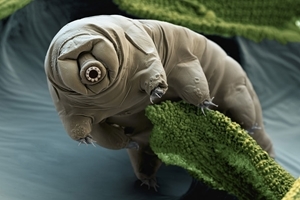Tardigrade
 One of the marvellous things about being interested in natural history, is the vastness of the subject.
One of the marvellous things about being interested in natural history, is the vastness of the subject.
For instance, if you asked me exactly what a tardigrade is, well my answer would be fairly succinct to say the least, probably along the lines that I have heard of them and they are tiny! Yet we are surrounded by these fascinating little creatures!
In 1767, a clergyman called Johan Eichhorn was looking through his microscope at some water he had taken from a pond, when he spotted a strange creature he had not seen before. He illustrated the animal in his book, but also wrote that it had “nothing which might have made it attractive to the eye”. A rather damning start for a newly discovered creature!
A few years later, another vicar, Johan Goeze, also came across this little animal and was altogether more smitten. He wrote: “Creator of the elephants and atoms, of whales and small living points in water! I am astonished by the endless variety of designs, according to which your wisdom has formed in a different way the body of each animal, the bird, the frog, the insect and the worm” (he thought that this creature was a type of worm). What both men had seen were tardigrades.
Despite tardigrades being tiny, never more than a millimetre in length, they have caused taxonomists a bit of a headache over the years, as it is not clear exactly what they are. They have bits that are similar to worms, but they also have legs like spiders or crustaceans, and their mouthparts resemble those of nematodes. In the end they were given their own taxonomic ranking – Tardigrada.
There are nearly 1,000 described species of tardigrade (which means ‘slow walker’) and most lumber along with a gait that resembles a bear, giving rise to the nickname ‘water bear’. Most are semi-aquatic, living not only in water but also in water films within mosses, lichens and soil. They are found across the world in all suitable habitats and are amazingly tough. Tardigrades can be desiccated, irradiated, asphyxiated, poisoned, put in a vacuum and frozen solid, and yet survive.
To do this they curl up, withdrawing their legs; the skin becomes impermeable and metabolism stops. It is then impervious to almost anything. In fact, it is, to all intents and purposes, dead. But, believe it or not this is a reversible death, as when favourable conditions return, it reanimates.
Finding tardigrades is fairly simple, but you do need a microscope. Take a bit of moss from a tree or off your roof and soak it for a few hours. Then squeeze out the material into a shallow dish and scan it with your microscope. In a good sample you will find scores of protozoa, nematodes, rotifers and, with luck, tardigrades!
Photo credit: Nicole Ottawa & Oliver Meckes / Eye of Science / Science Source Images
Peter Thompson
Advisory
Read more from Peter Thompson at his blog.

Download Peter Thompson's essential 26-page book, featuring beautiful photography and detailed profiles of Britain's wildlife
Download FREE >